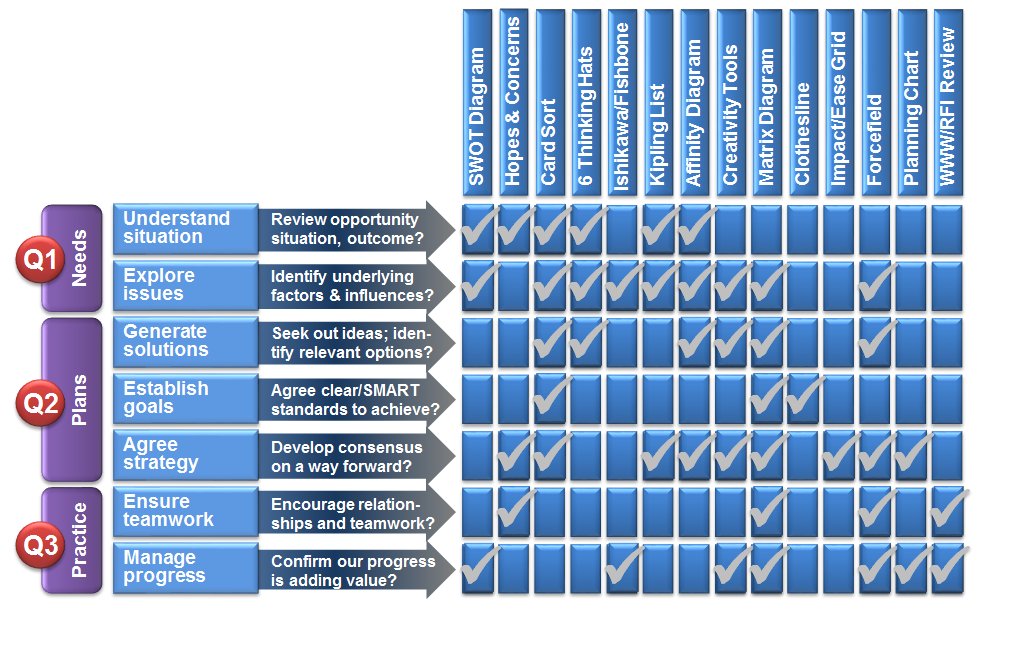There is a wide range of meeting tools available, which support the achievement of a host of different purposes within a meeting. So much so, that for people newly starting on this route, the options can appear overwhelming, and it is not uncommon for people who encounter this to ‘put it in the too-difficult box’ and simply ignore the massive potential that is available through these tools.
The reality is, there are a vast number of options, but you can make a large amount of progress with just a few of them – a starter set if you will – which together cover practically everything you are likely to need.
The diagram below has been created to help people to think through which of these tools will help them deliver what they are seeking to achieve in their meeting.
Using the chart is relatively simple – decide what it is that you are trying to achieve in a particular part of your meeting. Find this in the items down the left hand side of the chart (these should cover everything participative that you are likely to want to achieve in a meeting – see The Purpose of Meetings). Then look along the row to identify which of our short list of tools have something to contribute to this part of your meeting.

Then, use this links below to research the various tools highlighted, and to think through which specific templates you may need, and the best way to use them.
Further guidance on how to design your meeting, and the importance of these various elements can be found in Meeting by Design, which is available free of charge to clinic subscribers.
Meeting Tool List:
- SWOT Analysis : Enables people to gain an overview of the strengths, weaknesses, opportunities and threats within a situation.
- Hopes & Concerns : Provides an opportunity to voice the emotional cues that pertain to the risks and opportunities in a situation.
- Card Sort : Enables people to highlight and sequence ideas, concerns, strategies, issues that relate to the problem or the solution.
- 6 Thinking Hats : Provides a structured way for a group of people to articulate all of the factors pertaining to a situation.
- Cause and Effect Fishbone (Ishikawa) : Enables people to rigorously explore the contributing factors and causes of a problem.
- Kipling List : Provide a 6 point checklist which is useful for rigorous planning of action, or reviewing where such action went wrong.
- Affinity Diagram : A suprisingly effective means for engaging a group of people in grouping a large set of ideas or perspectives.
- Creativity Tools : A set of tools which push people outside of establish thinking patterns to take new perspectives on a situation.
- Matrix Diagram : A useful tool for understanding and planning the relationships between two things: e.g. objectives & actions.
- Clothesline : A tool for building consensus and insight around setting a target or aspiration for what is to be achieved.
- Impact/Ease Grid : A simple means for helping to prioritise a set of alternative actions/solutions based on likely effort & outcomes.
- Force-Field Analysis : A tool for exploring people’s motivations both for current behaviour, and for adopting new behaviours.
- Planning Chart : A tool for laying out all of the actions that need to take place, and for scheduling a timetable around them.
- WWW/AFI (Meeting) Review : A tool for reviewing the effectiveness of one meeting with the intention of improving others.
- Brainstorming : A tool for generating a large volume of ideas or perspectives quickly. Can be structured to improve quality.
Please subscribe to access clinic content
Subscription to the Inspirometer Information Service is free of charge and grants you instant access to a wealth of meeting effectiveness resources and guidance. It also provides you with regular updates direct to your mailbox at a frequency of your choosing.
I am happy to consent to the Inspirometer cookies and Terms and Conditions
Your use of the Inspirometer Information Service is subject to the following terms and conditions, and is subject to our privacy policy which can be reviewed here: https://inspirometer.com/privacy-policy
■ We will not use your information for any other purpose than to keep you informed of developments in meeting effectiveness and the Inspirometer system, and we will not share your information with others.
■ You are able to unsubscribe from this service at any time. Each email you receive from us will contain a link where you can reset your preferences for all future emails, or unsubscribe for the service entirely.
■ We will contact you on a minimum of a quarterly basis to ensure that our service is continuing to meet your needs, to give you a general update on key developments in our service, and to provide you with the option to change your contact preferences
■ We will hold your data on file to enable your access to the Information Service until such time as you unsubscribe from the service
■ If we hold your data outside of the information service as a result of you contacting us by email or purchasing our service, we will hold your data in accordance with our Privacy Policy (https://inspirometer.com/privacy-policy). We will delete such data, in situations where we are not legally required to retain it, on receipt of a verified request from you
■ All information provided by us is provided in good faith. All information submitted by you is to be provided in good faith.
■ In compliance with the GDPR 2018, you acknowledge that clicking the subscribe button grants us your consent to hold the data you have provided, and to contact you using that data, in the manner described above.
■ We will not use your information for any other purpose than to keep you informed of developments in meeting effectiveness and the Inspirometer system, and we will not share your information with others.
■ You are able to unsubscribe from this service at any time. Each email you receive from us will contain a link where you can reset your preferences for all future emails, or unsubscribe for the service entirely.
■ We will contact you on a minimum of a quarterly basis to ensure that our service is continuing to meet your needs, to give you a general update on key developments in our service, and to provide you with the option to change your contact preferences
■ We will hold your data on file to enable your access to the Information Service until such time as you unsubscribe from the service
■ If we hold your data outside of the information service as a result of you contacting us by email or purchasing our service, we will hold your data in accordance with our Privacy Policy (https://inspirometer.com/privacy-policy). We will delete such data, in situations where we are not legally required to retain it, on receipt of a verified request from you
■ All information provided by us is provided in good faith. All information submitted by you is to be provided in good faith.
■ In compliance with the GDPR 2018, you acknowledge that clicking the subscribe button grants us your consent to hold the data you have provided, and to contact you using that data, in the manner described above.
Track your progress to ensure the efficacy of this strategy.

